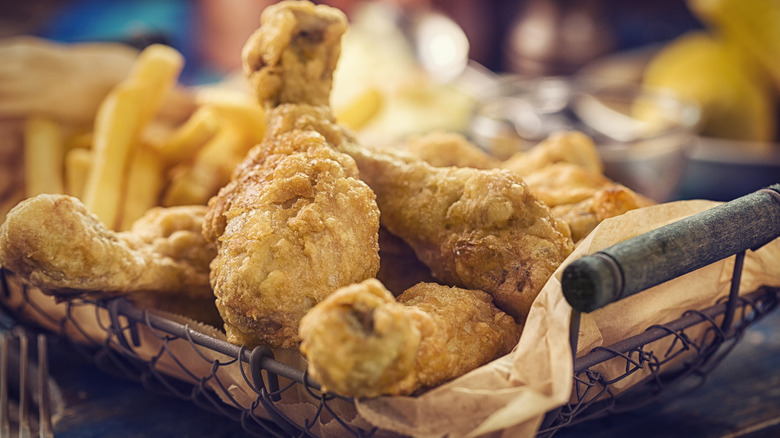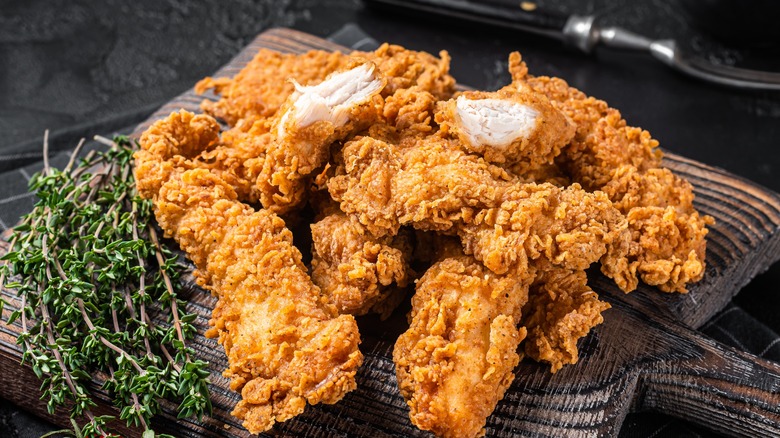For The Juiciest Fried Chicken, Brine It First
When you set out to make fried chicken, the first thing you should do is park your poultry in a salty, flavorful brine. This will give you plump, perfectly seasoned meat. To make a basic brine, all you need to do is add 2-4 tablespoons of kosher salt to a liter of water. This ratio can be scaled up to accommodate as much liquid as you need. Soak the chicken in this solution for roughly one hour per pound of chicken. The salty liquid dissolves the chicken's protein structure, making the meat tender. On top of this, the chicken absorbs water during the process and comes out more juicy.
Brining also makes cooking the chicken easier. Frying poultry is essentially a balancing act; you need to keep the actual meat moist and well-cooked while giving the exterior coating enough time to crisp up and brown. If you dredge and fry an unbrined chicken breast, for example, it can easily become painfully overcooked by the time the exterior has finished. By brining the chicken, however, you reduce its cooking time, which lets the meat and breading cook harmoniously.
Add these flavor-packed ingredients to your brines
While the simplest brines are made from just salt and water, you can use plenty of ingredients to add flavor to the meat. Swapping out water for buttermilk is a great option (there's a reason, after all, that buttermilk fried chicken is so famous). This ingredient is highly acidic, which means it will help tenderize the chicken even more. Buttermilk also helps your breading come out crispier too. Mix a little of it with your dry breading, and it will form little clumps that stick to the chicken and give it a craggy crust.
Another great liquid is something you might normally pour down the drain: pickle brine. This liquid is already intensely salty (though it's also an underrated hydration powerhouse), and it gives the chicken a tang that can lighten up some of the heavy flavors of fried food. This technique even cuts down your prep time, as you don't need to dissolve any salt.
You can also stick to a water-based brine and add aromatics, spices, or acids to this base. Try spiking the brine with lemon juice to infuse the chicken with citrus. Fresh herbs such as rosemary or parsley and dry ones like bay leaves are also welcome additions. If you go this route, bring the water to a boil with the ingredients so that they can infuse into the liquid. Just be sure to let it cool before adding the chicken.
Frying tips for the juiciest chicken
When it's time to fry your brined chicken, there are plenty of ways to ensure it comes out as juicy and tasty as possible. First, brush up on how to deep-fry things at home without burning anything. Use a large cooking vessel like a heavy-bottomed pot; a wok will work even better, as its sloped sides allow you to use less oil and make it easier to clean out debris. Reach for a neutral oil with a high smoke point, such as canola or grapeseed oil. It will handle the high temperatures needed for deep-frying, and its neutral taste won't impart any unwanted flavors.
It's essential to monitor your oil temperature with a food thermometer throughout the cooking process. You want to keep your oil around 350-375 degrees Fahrenheit while the chicken cooks. Don't place too many pieces of chicken into the oil at once, as this will significantly reduce the temperature and cause the breading to absorb excess oil. It also means it will take longer for everything to cook, potentially drying out your chicken. On the other hand, don't let your oil get hotter than 400 degrees Fahrenheit. Your exterior will burn before your chicken cooks through if this happens.



